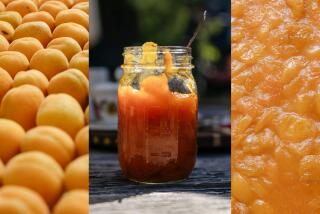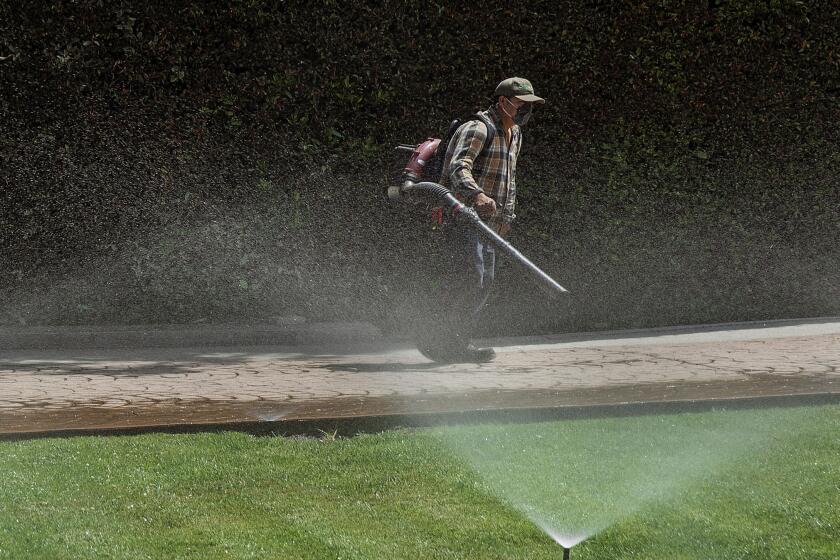Paradise Preserved
- Share via
Quinces, Aphrodite’s apples, are at once patrician and earthy. The fruit, golden as the sun, resembles a rumpled pear covered with downy bloom--the dust of centuries. A ripe quince’s perfume is a mix of musk and jasmine, lilacs, guavas and apples. The scent from a bowl can fill a room and drive you crazy.
How is it that a fruit the ancients revered, a fruit still esteemed around the world, is neglected here? Probably because the pale flesh of raw quinces is rough and astringent. But poach slices in syrup, stew chunks with honey, brush halves with sweet butter and slowly roast them, and their rosy color and complex perfume will fill your senses.
Whether in leaf or winter’s bareness, the quince tree makes a fine specimen. Limbs are dark and lightly crooked; fruit dangles * Jonathan Gold and Counter Intelligence are on vacation.
brightly on the bough. Trees grow slowly to 10 feet, but you can keep them at six to seven. And you can grow a tree in a half-barrel. In spring, there are cream-to-blush blossoms the size of a doll’s teacup. Spring through fall, broad oval leaves are new-green--in late autumn, they turn pumpkin and flutter to the ground. Don’t have a place for a tree? Coax yours into a handsome shrub, perhaps against a wall.
*
Quinces are self-fruitful and need no pollinizer--one tree alone makes fruit. Quince has modest chilling requirements, so it’s that rare pome fruit that thrives in balmy climates. Quinces actually prefer moist, heavy soil--clay people, rejoice!
An old wives’ tale has it that quinces thrive on neglect. Forget it--nothing and nobody does! All they ask for is sun and a fair amount of water. Happily in Southern California, the trees are little bothered by disease. Should you have a problem, consult a local county agricultural adviser.
Now’s a good time to buy a potted tree and set it in the garden, or (less expensive) order bare-root for delivery in spring.
Quinces ripen in September and October. Orange quinces are large and roundish, with deep golden flesh that turns the richest red of all when cooked. Pineapple quinces have a hint of pineapple in their white flesh. Less tart than Pineapple, Smyrna has pale-yellow flesh and keeps especially long. Green-gold Champion has delicately flavored flesh. Van Deman, Burbank’s cross between Orange and Portugal, produces ample spicy fruit. Cook’s Jumbo has white flesh and is enormous.
*
Around the turn of the century, quince trees flourished in America’s gardens and quinces were common in the kitchen. In “The Joy of Cooking” editions of the ‘30s, ‘40s and ‘50s, Irma S. Rombauer had a recipe for a quince liqueur she described as “given by a French priest to his friends.” As a recipe in a book ought, it mirrors the times: Four quarts of ground quinces stirred into three gallons of rye whiskey. Along with cherry bounce, blackberry cordial and peach brandy, the cleric’s liqueur was pulled from later editions.
Though one quince recipe was ejected, another was added. To me, paradise jelly has only one rival--the fabulous currant preserve from Bar-le-Duc in northern France. Over the years, as cooks do, I’ve fiddled with Rombauer’s recipe. I use crabapples for their incomparable jelly-making quality, and I add tiny seeds of vanilla bean. The whiff of vanilla is marvelous, and the specks suspended in the rose jelly are enticing. Sometimes, instead of vanilla, I lay a lemon, rose or nutmeg geranium leaf in the jar before pouring in the jelly.
These days you won’t find many recipes for quince in books, but you can use quinces in any recipe calling for apples. For example, inspired by Cecil Beaton’s iced apples in “The Alice B. Toklas Cook Book,” I made a divine dessert by poaching thin slices of fruit--half-apples/half-quinces--in lemon-flavored syrup until translucent, chilling them 24 hours in a deep dish, then unmolding them. Their pectin holds the shape and their color is breathtakingly rosy. Serve with custard sauce.
Remember to add gratings of quince to compositions of apples or pears--particularly pies, tarts and puddings. They’ll turn it rosy. And don’t forget the exotic uses of fruit with meats--quinces are superb with lamb and beef. Then look into chutneys and pickles, liqueurs and cordials, quince wine . . . .
*
If you’ve never tasted quince, get yourself to a market with a European, Latino or Middle Eastern clientele and ask for a tin of Mexican dulce de membrillo , French cotignac or Greek pastokithonia --or there may be ayva helvasi from Turkey or something from Morocco. This is the quintessence of quince, a sweetened puree slowly cooked down to jellied candy. My husband has made it, a labor of love. But then, it is Aphrodite’s fruit.
*
Sources:
Fruit--at the market.
Trees--Cook’s Jumbo, Orange, Pineapple and Smyrna, bearing age in 5- and 15-gallon containers, at (or shipped year-round from) Pacific Tree Farms, 4301 Lynwood Drive, Chula Vista, Calif. 91910; Orange, Smyrna and Van Deman shipped bare-root January through May from Raintree Nursery, 391 Butts Road, Morton, Wash. 98356; Champion, Pineapple and Smyrna shipped bare-root January through March from Sonoma Antique Apple Nursery, 4395 Westside Road, Healdsburg, Calif. 95448.
*
You must use a good strong knife and a steady hand to cut quinces. The flesh discolors as quickly as apple and pear, so keep pieces in a bowl of water with a splash of lemon juice. Do not core fruit, as stems and seeds have pectin and will be removed during draining anyway.
To waste not one whit of paradise jelly makings, I make paradise jam with the contents of the dripping bags. It’s homely but delectable. Puree the leftover fruits together, then press them through a fine sieve to retrieve the gritty bits. Combine in a heavy saucepan: four measures puree, three measures sugar, and a small lump of unsalted butter. Stir with a wooden spoon over low heat until thick--watch so it doesn’t scorch. A scented geranium leaf in the jar is a fine addition. Pot up and process as you do the jelly.
PARADISE JELLY
2 1/4 pounds quinces, fuzz rubbed off
2 pounds crabapples or use juicy, slightly tart apples such as Gravenstein, McIntosh or Jonathan
1 cup picked-over cranberries
Cool water
4 cups sugar
1 vanilla bean, slit in half lengthwise, seeds scraped out
Coarsely chop quinces and crab-apples separately, cutting pieces same size.
Separately cook quinces, crab-apples and cranberries in 3 nonreactive saucepans, with water to barely cover each fruit. Bring to boil, turn heat to low and simmer until fruits are soft but not mushy. Overcooking reduces pectin.
Line each of 3 strainers with dampened kitchen cloth and set over 3 bowls. Turn in fruits and let drip. When dripping slows, tie cloths into bags and suspend over bowls to finish dripping overnight. Do not squeeze bags.
Combine sugar and vanilla seeds, using back of spoon to separate clumps and mix seeds evenly through sugar.
In large, heavy, nonreactive saucepan, combine 2 cups crabapple juice, 1 1/2 cups quince juice and 2/3 cup cranberry juice (reserve excess juice for another jelly). Bring to boil over medium heat and simmer 5 minutes. Skim off froth.
Turn heat to low and mix in sugar. Stir with wooden spoon, meanwhile washing down any sugar crystals that form on sides of pan with brush moistened with cold water (this keeps crystals from forming in jelly later).
When sugar has dissolved, raise heat until syrup simmers rapidly. Cook without stirring until syrup reaches 222 degrees on candy thermometer, or until spoonful of syrup, turned on its side over pan, slides off in sheet, about 12 minutes.
Remove from heat and skim off any foam. Immediately pour into sterilized canning jars, leaving 1/4-inch head space. Wipe rims, set on new lids and screw rings on tightly. Set in kettle and cover with hot water by 1 inch. Cover, bring to boil and boil 5 minutes. At high altitude, add 1 minute for every 1,000 feet above sea level.
Lift out jars and set away from draft to cool undisturbed overnight. Check seal; center of lid should not wobble when pressed. If it does, replace lid and boil jar as before or keep jar refrigerated. Store in cool, dry place. Makes 5 (8-ounce) jars.
Each 1-tablespoon serving contains about:
55 calories; 1 mg sodium; 0 cholesterol; 0 fat; 14 grams carbohydrates; 0 protein; 0.30 gram fiber.
More to Read
Eat your way across L.A.
Get our weekly Tasting Notes newsletter for reviews, news and more.
You may occasionally receive promotional content from the Los Angeles Times.










